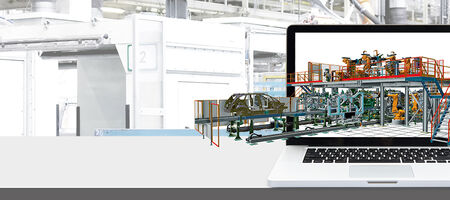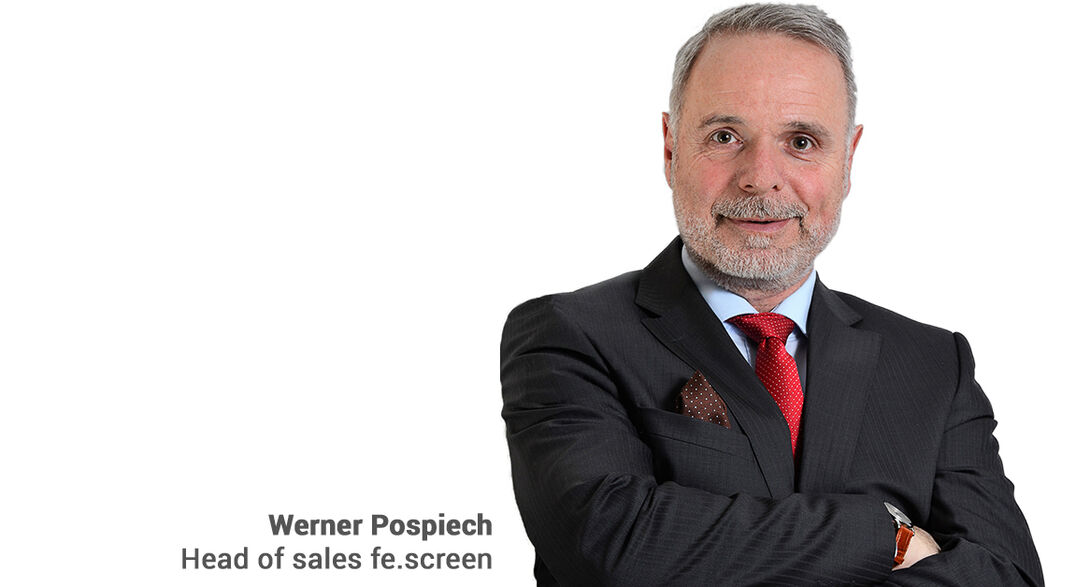Digital twins as as success factor in mechanical and plant engineering
Today, many companies from a wide range of industries are faced with the decision to establish virtual commissioning and an associated software solution in their workflow. Inevitably, they ask themselves whether this project will bring the success and benefits they expect.
This was also the case for the F.EE group of companies from Neunburg vorm Wald in the Upper Palatinate, which is currently one of the German market leaders in manufacturing and automation technology with around 1,100 employees. The company uses its more than 40 years of experience to develop products and services in the fields of automation technology, robotics, control cabinet construction, information technology and industrial software that are individually adapted to customer requirements.
Problems with real commissioning required response
"As a specialist for automation technology, we have been dealing with the topic of PLC simulation for about twenty years and with continuously optimizing the process of commissioning," explains Franz Weinzierl, technical managing director of F.EE GmbH. In the conventional way - i.e. before the introduction of virtual commissioning - a PLC software that had only been tested a little had to be put into operation in a short time. And that with the challenge that in some cases more extensive program adaptations had to be carried out on site. "Software errors remained undetected until late project phases, which had to be eliminated at great cost and time, even with plants already in production. For us, these circumstances were in urgent need of improvement - both for cost and efficiency reasons and in terms of customer satisfaction," explains Weinzierl. The goal was therefore to create options for safeguarding the control software and for risk-free testing of critical operating states and complex processes at an early stage of the project. At the same time, it should be possible to validate and optimize control strategies already in the engineering phase - on the one hand for the benefit of a shortened commissioning time, and on the other hand to reduce the personnel resources on site. The solution: virtual commissioning with the help of the digital twin.

High demands on the simulation tool
In the first step, the requirements for a simulation software for mechanical and plant engineering were defined in a practice-oriented manner. "An important criterion here was the correspondence between the virtual and real models. Depending on the customer or project requirements, it must be possible to realize both a highly idealized and detailed plant simulation," explains Weinzierl. An open and powerful software architecture and programming language provide the basis for being able to map large as well as complex plants with a large number of programmable logic controllers (PLCs) in just one simulation environment, without the hardware requirements exceeding those of standard PCs. Multi-user capability", which enables several users to work simultaneously on a simulation, must also be guaranteed. At the end of the intensive first phase and the subsequent market analysis, it was clear: The automation specialist F.EE develops its own software solution for simulation and virtual commissioning. The name "fe.screen-sim" was very obvious, since the "Software for INDUSTRY" product line with the name "fe.screen" already existed at F.EE.
First project already brought the breakthrough
In 2014, the time had come: The developed simulation tool was able to prove its capabilities for the first time within the scope of a pilot project. F.EE received an order from an automobile manufacturer for the integration of an electric overhead conveyor with approximately 500 transport and 250 assembly vehicles. The entire plant including eight PLCs was simulated at F.EE. Thus, in cooperation with the customer, all travel and special travel modes, storage as well as infeed and outfeed logics could be tested in advance. "The real commissioning went absolutely smoothly, we were able to achieve a 100 percent start of production and after about one week we could already start with the availability test," Franz Weinzierl explains the resounding success of the project.
Early integration of all parties involved
Step by step, the structures and processes required for virtual commissioning were established within F.EE, thus gradually increasing efficiency. "We have made the experience that the earliest possible involvement of the customer and all those involved in engineering - i.e. also mechanical and electrical design - in the workflow of virtual commissioning, is an essential success factor for its introduction and ongoing establishment in the company. The earlier all those involved define a common process, the more effectively it can be implemented in the end," Weinzierl points out.
Customer requirements demand flexibility
Employees with a basic understanding of plant functionality and PLC programming - so-called "virtual mechanics" - are responsible for creating the digital twins at F.EE. The way in which the models are created is project-oriented. The type of model creation is determined on a project-specific basis by the customer and the information provided. "Ideally, we receive 3D data from the engineering tools. Via a direct TCP connection with "fe.screen-sim", all data and information can be transferred digitally. Here, the possibility of bidirectional data exchange - i.e. the transfer of changes made in the simulation tool back to the CAD software - is essential," explains Weinzierl. The product flexibility of "fe.screen-sim" also ensures that only idealized models can be created if only a simulation of the signals is required.
Focus on optimization
Even after the successful implementation of virtual commissioning, the focus at F.EE is on further process optimization, with the practical experience gained being continuously incorporated into the further development of the "fe.screen-sim" simulation tool. Among other things, the company sees potential for improvement in the availability of behavior models, which are used to emulate the properties of a real component in certain subareas. Here, according to Weinzierl, it would be desirable if all manufacturers also provided a digital model that can be configured in terms of the degree of idealization in addition to the physical components.
Virtual commissioning as a success factor
The advantages of virtual commissioning for mechanical and plant engineering are clear and obvious. "In particular, the ability to use the digital twin to perform feasibility analyses at an early stage of the project with the involvement of all project participants and to completely test the PLC software, including emergency, storage and retrieval strategies, significantly increases efficiency," is the summary of F.EE's technical managing director. In addition, the digital twin can also be used for training and familiarization purposes by means of VR technology, and the multi-user capability represents a considerable advantage, especially in special machine construction or with very complex systems. F.EE was also able to benefit from the advantages of virtual commissioning during the Corona pandemic, when deployments to global customer sites were hampered by travel restrictions. "We created a plant model for a China-based customer to optimize cycle time and commissioned it virtually. In the end, it was sufficient to send only the optimized and secured PLC program to the plant operator. F.EE employees did not have to be on site." The conclusion of the automation specialist is absolutely positive: The software quality for delivery was significantly improved by the use of digital twins. This eliminated the need for costly and time-consuming tests on the real plant as well as bug fixing and rework measures.
"At our company, no project is ever implemented without virtual commissioning."
Interview with Franz Weinzierl, the technical managing director of F.EE GmbH.

What were the reasons for your decision to develop your own simulation software?
Weinzierl: During the market analysis, it turned out that none of the available simulation tools could sufficiently meet our high requirements in terms of functionality and practical relevance. That's why we decided to develop our own software solution, which has proven to be absolutely right and meanwhile a stroke of luck. Because today we are a competent partner for our customers in all areas of virtual commissioning. Depending on the requirements, F.EE uses simulation solutions from a wide range of providers, which has enabled our employees to acquire extensive user know-how over the years. At the same time, we have been able to establish a high-performance simulation tool on the market with "fe.screen-sim", which is continuously developed further in a very practice-oriented manner. Since we ourselves have gone through the process of introducing virtual commissioning in the company, we know the challenges and pass on the experience gained to our customers.
What does the software solution look like for you in detail?
Weinzierl: The modular structure of "fe.screen-sim" guarantees us the greatest possible flexibility. We primarily work with the modules "CAD Importer", "Logic Creator" (in FUB and C#) and "Interaction". Depending on the customer project, we also use the "EHB" and "VR" modules. We also use the corresponding interfaces to connect robots and PLC controllers from a wide range of manufacturers.
What challenges did you face during the implementation process?
Weinzierl: At the beginning, our employees were somewhat skeptical about the new software solution - also with regard to the additional work in the prototype phase. In the initial period, the amount of work was actually somewhat higher compared to the real startup. However, acceptance was already very high after the first few projects, as the advantages of virtual commissioning already clearly outweighed the disadvantages.
What employee-related conclusion do you draw for virtual commissioning at F.EE?
Weinzierl: For our employees, virtual commissioning is now an absolutely necessary process within our toolchain and contributes greatly to quality assurance in the company. With the help of the digital twin, we now commission plants on site within five days that used to take us three weeks. Shorter site visits have allowed us to increase employee satisfaction, lower stress levels, and reduce project costs. This is another reason why no project at F.EE is implemented without prior virtual commissioning.
You can also read the entire article in the online edition of "IT&Production".
Your personal contact person – for more clearness
You are a project or department manager and are faced with the question of how to set up a digital twin for your project? We would be happy to talk to you personally about your requirements, the time frame, the possible project approach and give you an initial cost estimate.








